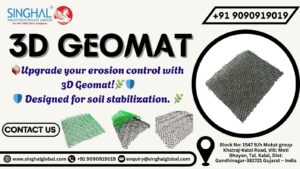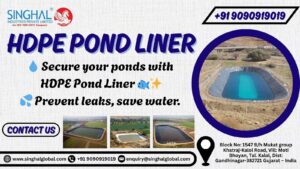The 3D Geomats are transforming how we approach land erosion and vegetating it; be it in stabilizing railway embankments in India or in greening up drubbed riverbanks following monsoon. But it is not just their story of technical innovation, but of practical solutions that can enable engineers, city planners and even farmers to find a balance between nature and infrastructure. Let’s explore what makes the science of 3D Geomats so special, how installation really plays out, and what buyers (and skeptics) need to know about the real-life impact, price, and supply market.
What Is a 3D Geomat and How Does It Work?
A 3D Geomat in India is a three-dimensional structured, artificial, geometrical network of interlaced filaments, commonly of recycled, or eco-friendly polymers. Unlike flat sheets, its layered, porous network provides pockets for soil, seeds, and roots. The mat holds soil in place, shields it from rain and runoff, and gives new vegetation a “grip” as it sprouts and establishes.
- Multi-layered Structure: Traps soil particles, stabilizes slopes, and prevents erosion.
- High Water Permeability: Allows rain to pass through, reducing runoff while supporting root hydration.
- Flexible and Lightweight: Conforms to uneven terrain—slopes, riverbanks, ditches, even sporting fields.
A highway engineer near Pune remembers a nightmare monsoon season two years ago: “Our embankment was crumbling. The 3D Geomat locked the top layer, and grass came back faster than I ever expected.”
Erosion Control and Vegetation: The Science Explained
Soil erosion is a silent but devastating force—stripping topsoil, causing landslides, and damaging crops. The genius behind 3D Geomats is in mimicking nature’s own techniques for holding soil: rooting and binding. The mat’s web traps both soil and plant roots, distributing the force of rain or water flow. This means the earth holds together, not only because of the mat, but eventually because of the self-reinforcing network of grass, trees, or shrubs growing through it.
- Early Stage: Geomat gives bare soil, which minimizes the destruction of rain and wind as soon as it is installed.
- Establishment: Seeds are sown (or allowed to naturally colonize), roots grow through the mat.
- Mature Slope: Combined root-mat system can withstand high velocity water, up to 6m/sec, and even extreme rains.
A project in Assam showed how the rapid germination and deep rooting, thanks to moisture held in the mat, improved survival rates for native grasses along highways. “It traps seeds the wind would have blown away,” one field supervisor noted.
Installation: Fast, Flexible, and Surprisingly Simple
The 3D Geomat suppliers often boast about easy setup—and that’s usually true. The mats arrive in rolls. Workers spread them on prepared soil, pin or anchor the edges, and then either sow seeds, lay turf, or let natural growth take over.
Typical installation time: A trained team can install 200–500 square meters in a single day, depending on slope and complexity.
For a railway slope stabilization project, a team in South India laid down kilometers of matting in ten days—“Much simpler than stone pitching,” the contractor reported.
Can 3D Geomats Handle Tough Conditions?
Buyers, especially in India, often raise the question: can a synthetic mesh really handle monsoons, landslides, or rapid river flows? Yes: Lab and field tests show that with more than 80% vegetation cover, 3D Geomats withstand high-velocity flows and heavy rain (up to 6m/sec for mature, rooted sites).
- UV and Temp Resistant: Made from UV-stabilized polymers for a lifespan of 10–30 years.
- Chemically Stable: Does not break down due to farm chemicals, road salt or moderate pollution.
A caveat? For permanent water submersion or chemical spills, specialty variants or extra anchoring might be needed. Skeptics say: “It still needs roots!”—and that’s correct: the combination of mat plus vegetation delivers the real magic.
Applications Beyond Slopes: Roads, Railways, Urban & More
You’ll find 3D Geomat in India not just on slopes, but:
- Road/rail embankments
- Riverbank and coastal protection
- Urban park hillsides, sports fields
- Mining and landfill capping
- Restoring land after construction or natural disasters
Infrastructure planners like their adaptability—a highway verge might need thick matting, while urban green roofs demand custom sizes and lightweight composition.
Price, Value, and Sourcing in India
So, what’s the 3D Geomat price in India? The prices are between ₹180 and ₹400 per square meter, depending on the grade of the polymer, its thickness, density of the mesh, and custom options. Bulk projects are cheaper, particularly when the connection is made with the 3D Geomat suppliers or manufacturers at the highest level.
One government dam project was feeling budget constraints but it saved on future repair: “Jute matting cost less than geomat upfront, but the dam in two years cleared of any washout made it a better deal.
Leading 3D Geomat Suppliers in India
India boasts of a good supply ecosystem with well established companies such as Singhal Industries (Ahmedabad), Gabion Technologies, Maccaferri India and the local suppliers being listed on sites such as IndiaMART and TradeIndia. A lot of them offer regular and tailor-made mats, as well as professional installation instructions.
Conclusion
Is 3D Geomats perfect in all scenarios? Not always. They are fantastic for quick stabilization and supporting native plant return, but in extreme conditions (bare rocks, salty tidal zones), other measures—like concrete, riprap, or gabions—may still be needed. Still, as a “green” fix that enables nature to take over, many engineers and ecologists agree the benefits far outweigh the initial cost.
For anyone facing tricky slopes, crumbling riverbanks, or costly urban landscaping, 3D Geomat in India is a solution that’s both scientific and refreshingly practical. And for the next generation of green construction, it just might be the bridge between building and biodiversity.
Frequently Asked Questions (F&Q)
Q1. How does a 3D Geomat prevent soil erosion?
By forming a 3D network that holds soil in place, traps seeds, and reinforces root growth, distributing the force of water or rain and stabilizing the surface.
Q2. How long does it take to install a 3D Geomat?
Installations can often be completed in hours; teams may lay 200–500 sqm per day, varying by project.
Q3. Can 3D Geomats handle heavy rainfall or water flow?
Yes, once established with 80%+ vegetation, they resist rain and water flows up to 6m/sec.
Q4. Can 3D Geomats be used in road and railway projects?
Absolutely—they are standard on many highway embankments, tracksides, bridges, and cuttings across India.
Q5. Who is the largest Suppliers of 3D Geomat?
In India, the two 3D Geomat suppliers, Singhal industries and Maccaferri, have strong network of distribution and technical support.









